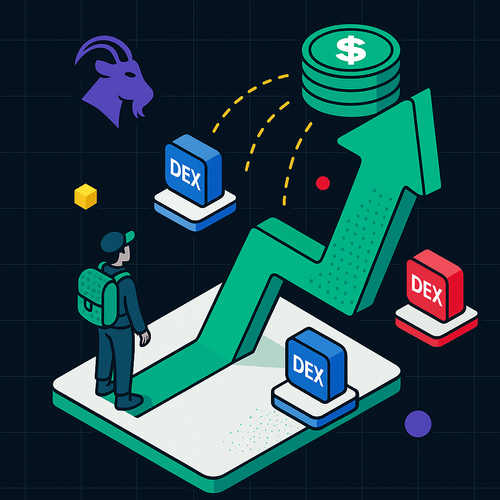TLDR
An IBC-enabled DEX within the Cosmos ecosystem that is designed for customizability and rapid design space.
It is the largest DEX and it is offering LPs liquidity incentives through its governance token OSMO. LPs can permissionlessly create pools and design parameters to their needs because the protocol uses self-governing liquidity pools.
Osmosis Overview
Osmosis is a DeFi app-chain that is building out a core AMM protocol on the Cosmos stack. It is IBC enabled so it can trustlessly interoperate with other Cosmos chains such as Akash and bring forward the modularity of the Cosmos ecosystem. As of now, many of the chains launched on Cosmos do not reflect the popular DeFi applications on other layer 1s; instead, the ecosystem has been a focused on things like decentralized cloud computing (Akash), VPN services (Sentinel) and much more but certainly not DeFi.
The AMM design of Osmosis closely resembles the Balancer AMM model but is reimplemented into the Cosmos SDK. Osmosis is a generalized AMM with flexibility, weights, multi-asset pools, etc. It currently provides liquidity pools for most of the long tail assets on IBC-enabled chains but does not have a highly liquid stablecoin pair so TVL can be lacking for the time being. Most of the TVL stems from two assets - OSMO and ATOM. We expect to see a rise in volumes and TVL as more Cosmos chains enable IBC which will bring forward new sets of assets.
The Cosmos ecosystem is focused on creating localized systems. Osmosis is its own independent chain with its own validators, staking token (OSMO) and security model. It was built using the Cosmos SDK and the Tendermint software stack. It was able to bootstrap its validator set by airdropping $OSMO to the Cosmos Hub validators (those staking ATOM). They currently offer 16 incentivized pools on their AMM with liquidity incentives using the OSMO token. Osmosis is very customizable and is intended for experimentation. Users can create permissionless pools with two or more assets and custom weights - it all depends on the pool. The parameters of the pool are voted on through governance and can be customized.
Osmosis has been live for many months and has well over $400 million in liquidity and processes nearly $10 million in daily volumes at the time of writing.
The team is a combination of former Tendermint engineers and the team behind the Keplr Wallet.
Audits: Was not audited at launch but is undergoing multiple audits. The protocol has been tested for bugs by its own engineers.
Osmosis Roadmap
Given Osmosis is an app-chain, it controls all layers of the stack. From the protocol layer to the end user wallet, the team is able to optimize for new features and push forward the design of DEXs as we know them today. Given the launch product of this DeFi chain is an AMM, it is no surprise the Osmosis team has been exploring the AMM design place. They are currently optimizing amongst many different AMM designs such as concentrated liquidity. Some of the main features they are working on include the following:
Threshold encryption to help solve front running
Encrypts all txns in the mempool to a threshold key of all the validators
Once the validators commit and finalize the ordering of the block, then the txns will be decrypted and executed - can't frontrun/sandwich attacks
Sunny and others were working on this prior but prioritized the AMM given this is a feature, not a product
Superfluid staking
- the ability to stake your OSMO while simultaneously liquidity providing - increases capital efficiency and increases the security of Osmosis without the same tradeoffs of liquid staking derivatives
- Example: You provide liquidity to a pool with OSMO and another coin, then you can stake the LP share and simultaneously stake the underlying OSMO of the LP token.
Interfluid Staking
- similar to the above, but for other Cosmos native assets in the pool with OSMO. This allows both assets in the pool to be staked in their respective chains (they get security from liquidity) and users get more APR for their LPs
Sources of fees to LPs with Interfluid staking: farming rewards, OSMO staking rewards, other Cosmos SDK token staking rewards, and trading fees
- Example: Bob LPs in an OSMO-AKT pool on Osmosis. On top of the juicy APRs Bob sees on the Osmosis UI, he wants to interfluid stake his LP. So Osmosis takes the underlying OSMO tokens in the LP pair and stakes them - Bob begins earning OSMO staking rewards on top of the APR. What about the underlying AKT in the LP token? The AKT is attested over IBC back to Akash, and the native AKT is staked on the Akash chain. Bob is earning more revenue because of the staking rewards for both assets and now each chain is fundamentally more secure (increased bond ratio of the native staking token)
- Makes Osmosis liquidity more attractive given Cosmos chains can get partial shared security from deep liquidity
Batching system to create a more fair mechanism
- Everyone gets the average price across all permutations of orderings within a block
Cosmos DEX Landscape
Osmosis is not the only DEX within the Cosmos ecosystem. There are other DEXs like THORChain, Secret Network, and the Gravity Dex. THORChain is addressing a much different market than Osmosis at the moment such as Bitcoin and Ethereum, while Osmosis is focused more on IBC-enabled chains and Osmosis does not need to maintain a large bridging infrastructure. Osmosis will enable a cross-chain swap feature later down the roadmap which can take advantage of protocols like Axelar Network which are bringing native bitcoin onto Cosmos.
Secret Network is more focused on a privacy-centric model and the Gravity Dex is not fully live yet and does not offer liquidity mining rewards. Finally, Sifchain is also in the picture but they have a lot of bridge infrastructure they must maintain - which takes away from core AMM features for the DEX. For these reasons, we feel Osmosis is positioned to do well as the DEX landscape matures on Cosmos. Regardless of the winning DEXs, it looks to be a symbiotic relationship between some of them - Osmosis tokens can benefit from the privacy-preserving Secret Token equivalents on the Secret Network and the Secret Network can benefit from the liquidity found on other IBC apps.
Given tokens are path dependent in Cosmos, tokens sent over different IBC paths might not be fungible with one another (fragmented liquidity). Given this, it is likely that Cosmos takes a Hub and Spoke Architecture - we’d expect the same for DEXs so it'll be very important to keep track of the traction and newly shipped features as a precursor to the DEX Hub of Cosmos (still very early days given how nascent the DeFi apps are compared to Ethereum).
IBC
Inter-Blockchain Communication (IBC) is a generalized messaging protocol that can be used to build a wide range of cross-chain applications. Some use cases include value transfer, interchange assets and services, and the ability to connect with other IBC-enabled chains - without running into trusted multisigs or validator-secured bridges.
- It has some issues scaling to millions of chains given the relayer infrastructure needed to support many connections. In fact, if Cosmos had 1000 chains with IBC enabled, it would require 1000*(1000-1)= 999,000 unique relayer channels - this is a lot of infrastructure to maintain. Given it is still just a few dozen chains, this is nothing to worry about yet but something to strongly consider in the future if the Cosmos thesis is to play out.
Osmosis can communicate with other chains in the Cosmos ecosystem like the Cosmos Hub, Akash Network, Regen Network, Crypto(dot)com, Sentinel, and many others that have IBC enabled.
Track the activity of IBC Zones here
Tokenomics
Fair Launch - No VC Backing
Airdropped OSMO through a quadratic airdrop to ATOM stakers based on the amount of Atom tokens in his/her wallet.
- Helped distribution be more decentralized - ensures ATOM whales didn't get the majority of the OSMO airdrop.
OSMO (Security + Governance + Utility)
OSMO is used as a governance token for the following:
- Future roadmap and software upgrades
- Other parameters in the system
- Per pool governance - gives LPs more power over their own pools
- Change parameters of the pool without splitting liquidity
- Specify which pools can be used for superfluid staking
- Native staking token of the Osmosis chain
- Useful asset within pools
ION - a secondary token
- Meme coin - devs are keen on giving it value
- Awaiting CosmWasm to be enabled
Possible strategies
16 active pools with liquidity incentives
- The lowest APR was around ~88% - paid out in OSMO daily (at the time of writing)
If you are positioned in OSMO or ATOM, there are good returns for being an LP
- All base pairs are either OSMO or ATOM
ATOM and OSMO are highly correlated
- OSMO is a higher beta play on ATOM at the time of writing
Stake OSMO for ~100%
- 1 to 14 days to unbond
- The yield is higher the longer you bond your LP pair
- Reverse staking derivatives (superfluid staking) are on the roadmap
Catalysts
Terra successfully upgraded to Columbus-5
- Brings a highly liquid stablecoin, Mirror assets, Anchor assets and the many other applications launching on it
- It will significantly boost the TAM of Osmosis and will help grow a more diverse set of liquidity pairs
- Exposes Osmosis to any risk of UST depeg
More chains adopting IBC and establishing connections with Osmosis and having their liquidity come over
- Internal and external incentives for these pools
- It is the first time a lot of these long-tail assets have liquidity
3rd party Bridge for more liquidity
- Axelar Network
- Is aiming to connect many chains - bitcoin, EVM chains, Polkadot, and many more
- It is currently in testnet and raised a round from large funds
- Axelar Network
- Airdrops from external applications to Osmosis stakers and LPs on their pools.
- Superfluid Staking will be a huge advance in PoS - increases the security of the chain and earns more APR for bonded LP tokens
Key Takeaways
The protocol has seen tremendous growth since it first launched in July. It is important to note that this growth was done with the longer tail assets within Cosmos. We expect to see a significant increase in TVL, volumes and overall fees earned by Osmosis LPs as other ecosystems bring in more liquidity - whether this be through IBC or a trusted bridge setup for ERC-20s and majors. Specifically, a highly liquid stablecoin will likely boost TVL and volumes as it is severely lacking within Cosmos.
We feel that Osmosis is the best positioned DEX in the Cosmos ecosystem at the moment. We expect to see a mutually beneficial relationship between Osmosis and the other DEXs within Cosmos moving forward whether they bring forward alternative designs like an orderbook model or more diversified assets.



